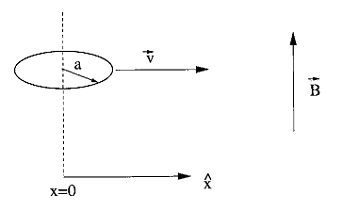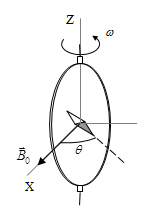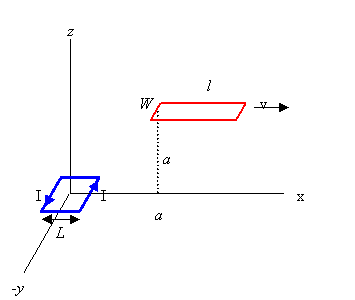Faradays law/Motional emf
Problem:
A loop of radius a and mass M made of resistive material
has a total resistance R. At t = 0, the loop is located at x = 0 and moves with
velocity v0 i. The loop lies in the x-y plane. There is a
magnetic field B = B0 (x/x0)
k. How far
does the loop travel before stopping?

Solution:
- Concepts:
Faraday's law
- Reasoning:
The magnetic flux through a filamentary loop is changing with time.
This flux change induces an emf. The emf causes a current to flow,
which dissipates energy.
- Details of the calculation:
Flux F = πa2B
= πa2B0x/x0.
|emf| = ∂F/∂t
= (πa2B0/x0)∂x/∂t
= (πa2B0/x0)v.
I = emf/R. P = I*emf = emf2/R. The power dissipated
must equal the rate at which the loop looses kinetic energy.
emf2/R = -Mvd(v/dt). dv/dt = -bv with b = (πa2B0/x0)2/(RM).
v(t) = v0exp(-bt).
The distance the loop travels before stopping is
d =
∫0∞v(t)dt
= -(1/b)v0exp(-bt)|0∞
= v0/b =
v0RMx02/(πa2B0)2.
Problem:
(a) A closed circular coil of N turns, radius a and total resistance R
is rotated with uniform angular velocity ω about a vertical diameter in a
horizontal magnetic field B0 = B0i.
Compute the emf ε induced in the coil, and also the mean power
<P> required for maintaining the coil's motion. Neglect the coil self
inductance.
(b) A small magnetic needle is placed at the center of the coil, as shown in the
figure. It is free to turn slowly around the z-axis in a horizontal plane, but
it cannot follow the rapid rotation of the coil.

Once the stationary regime is reached, the needle will point in a direction
making a small angle θ with B0. Compute the resistance R of the coil in terms of
this angle and the other parameters of the system. (Lord Kelvin used this method in the 1860s to set the absolute standard for
the ohm.)
Solution:
- Concepts:
Induced emf, the magnetic field at the center of a
current loop
- Reasoning:
The changing magnetic flux through the rotating loop produces an emf, which
causes a current to flow. This current produces its own magnetic
field.
- Details of the calculation:
(a) After some time t, the normal to the coil plane makes an angle ωt with the magnetic field
B0 = B0i. Then, the magnetic flux through the coil
is Φ = NB∙S, where the vector surface
S is given by
S = πa2(cos(ωt)i + sin(ωt)j). Therefore Φ
= NB0πa2cos(ωt).
The induced emf is ε = -dΦ/dt = NB0πa2ω sin(ωt).
The instantaneous power is P = ε2/R. The mean power is <P> = (NB0 πa2ω)2/(2R).
(b) The total field at the center the coil at the instant t is Bt =
B0 +
Bi, where Bi is the magnetic field due to the induced current
Bi = Bi(cos(ωt)i +
sin(ωt)j) with Bi = μ0NI/(2a) and I =
ε/R.
[cos(ωt)i +
sin(ωt)j is the direction of the vector surface
S.]
Therefore Bi = μ0N2B0πaω sin(ωt)/(2R).
The mean values of its components are
<Bix> = [μ0N2B0πaω/(2R)]<sin(ωt)
cos(ωt)> = 0,
<Biy> = [μ0N2B0πaω/(2R)]<sin2(ωt)> = μ0N2B0πaω/(4R)].
For the total field we have
<Bt> = B0i + μ0N2B0 πaω /(4R)]j.
The needle orients along the mean field, therefore tanθ = μ0N2πaω/(4R).
Finally, the resistance of the coil measured by this procedure, in terms of
is
R = μ0N2πaω/(4tanθ).
Problem:
A square loop of wire with sides of length L carries a time-independent
current I and is located at the origin. A rectangular loop of wire of length l
and width W is moving parallel to the x-axis in the positive
direction at a constant velocity v. Its width is so small that the
variation of the field along its width may be neglected. At t = 0, the
nearest edge of the rectangular loop has the coordinates (a,0,a),
where a >> L. Find the induced emf in the rectangular loop at t = 0.

Solution:
- Concepts:
Dipole moment, dipole field, induced emf
- Reasoning:
The small current loop at the origin has a dipole moment, and its magnetic
field is approximately a dipole field. The rate of change of the flux of
this field through the rectangular loop is proportional to the induced emf in
the rectangular loop.
- Details of the calculation:
Let us use Gaussian units.
The dipole moment of the loop is m =
k IA =
k IL2
= k m.
The magnetic field produced by this loop at r (r >> L) is
B = km(3(m∙r)r
- mr2)/r5 = km(3mzr -
kmr2)/r5.
(km = μ0/(4π))
The induce emf is ε = -(∂F/∂t), with F = ∫A(B∙k)dA.
B∙k =
km(3mz2 - mr2)/r5 = kmm(2z2 - x2)/(x2
+ z2)5/2.
At t = 0 F =
∫A(B∙k)dA
= Wkm
∫aa+ldx
m(2a2 - x2)/(a2 + x2)5/2
After the loop has moved a small distance dx', the flux is
F = Wkm
∫a+dx'a+l+dx'dx
m(2a2 - x2)/(a2 + x2)5/2
The change in flux therefore is
∂F/∂x'
= -Wkmm(2a2 - a2)/(a2 + a2)5/2
+ Wkmm(2a2 - (a + l)2)/(a2 + (a + l)2)5/2
= Wkmm[-1/(25/2a3) + a2(1- (l2
+ 2al)/a2)/(2a2(1 + (l2 + 2al)/(2a2)))5/2]
= Wkmm(1/(25/2a3))[-1 + (1 - (l2 + 2al)/a2)/(1
+ (l2 + 2al)/(2a2))5/2]
∂F/∂t
=
(∂F/∂x')(∂x'/∂t)
= Wkmmv(1/(25/2a3))[-1 + (1 - (l2 + 2al)/a2)/(1
+ (l2 + 2al)/(2a2))5/2]
ε = -(∂F/∂t)
= Wkmmv(1/(25/2a3))[1 - (1 - (l2 + 2al)/a2)/(1
+ (l2 + 2al)/(2a2))5/2]



